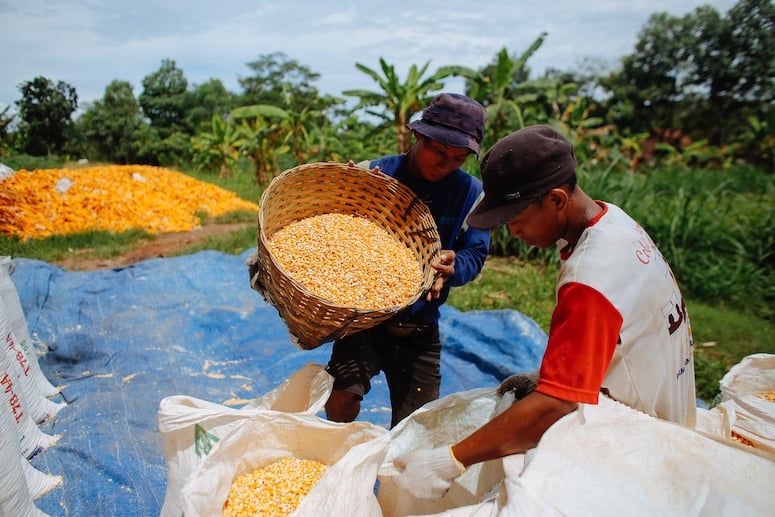Impact Investing Lessons for NGOs: Mercy Corps’ Scott Onder Discusses its Social Venture Fund
Foundations have been involved with making equity and debt vehicle impact investments in businesses since the term was coined over a decade ago. But non-governmental organizations … not so much. So why would an international NGO that specializes in humanitarian disasters get into the impact investing game? To Scott Onder, managing director of the 2-year-old Social Venture Fund (SVF) at Mercy Corps, the better question is: Why not?
Mercy Corps operates in 40 countries with a staff of nearly 5,000 – most of whom are citizens of those countries and working to manage crises that are gripping their homelands. But Mercy Corps personnel also are regularly working with businesses that are developing sustainable business models for sustained societal benefit. Onder makes the case that few organizations are better suited to conduct due diligence on would-be investment deals.
I won’t spoil the conversation below, but what’s most interesting to me is how SVF worked to develop a fund and marshal investors for it, in ways that are worth sharing for strictly for-profit investors, as well as nonprofit foundations and INGOs alike. The organization is doing quite a bit to share those insights with other INGOs. But as Onder points out, to do this right, an organization needs to go in with the right expectations. They also need to jump in and fully commit to a new kind of risk that for many will be unfamiliar.
SA: What was the genesis of the Social Venture Fund? What did Mercy Corps see in terms of a market opportunity?

Scott Onder
SO: In 2015 Mercy Corps established the Social Venture Fund (SVF) to invest in and accelerate the growth of innovative, scalable ventures that have the potential to positively impact millions of people in the developing world.
The creation of SVF wasn’t really an a-ha moment though. A few factors came together at the right time to make this concept a reality.
One factor was our history and willingness to experiment with new approaches to development. Mercy Corps sees complex global challenges as an invitation to pioneer paths out of poverty, to forge novel partnerships and to create solutions that break through entrenched challenges. And, at the same time, the organization recognized that the traditional grant-based model of funding international development can be limiting and rarely promotes the flexibility and experimentation required to test new models that could sustainably deliver social benefit to millions. Since social entrepreneurs worldwide are at the forefront of introducing such new models, Mercy Corps saw that impact investing presented a compelling opportunity to achieve increased scale, innovation, sustainability and partnerships in international development.
Another factor was the persistent market need. Social ventures are often deemed too early and risky for most traditional forms of financing when they are starting up. While numerous investors are willing to provide financing after a startup has proven commercial viability, few investors are willing to fund an early stage company. This “pioneer gap” is one of the biggest barriers ventures face in validating their model, and this was the market gap that we thought an INGO is best positioned to fill.
Lastly, was internal traction around the broad concept. We were already undertaking efforts to support our own staff’s entrepreneurial ideas to address the development challenges they saw in their daily work. As we incubated business ideas internally and reviewed the competitive landscape for our potential ventures, we ran across entrepreneurs outside of Mercy Corps with similar ideas – and a sense of urgency and resourcefulness that only entrepreneurs have. We thought that rather than constraining ourselves by investing only in our own staff that may spin out business, we could invest in entrepreneurs who had taken the leap to set up a company, recruited talented people and launched a new product or service out in the market
With that, the Mercy Corps Social Venture Fund was born.
SA: How did the organization structure it and find investors?
SO: SVF was initially capitalized by philanthropic sources. In order to address the early stage pioneer gap, we wanted a source of funds with a higher risk appetite than commercial capital. At the same time, we strongly believe that equity and convertible note investment are the appropriate structures for early-stage companies to take their growth to the next level. So, we reached out to individual donors (now known as our Impact Partners) to seed the fund and get enough capital to prove out the concept. Many of these Impact Partners are successful entrepreneurs, investors and executives. They saw the potential of this tool and emerging social enterprises to deliver long-term, sustainable impact and decided it would be a donation well used.
Mercy Corps then set up a wholly owned, for-profit holding company structure to make the equity or convertible note investments. This company is guided by a Board of Directors distinct from the Mercy Corps Board of Directors and is managed by the Social Ventures team. Together with our team, the Board agreed to make SVF an “evergreen fund.” As we come across opportunities for responsible exits, financial returns will recycle back to the SVF for future re-investment into other seed-stage enterprises, amplifying the impact of donations to the SVF but not returning capital to donors.
We are considering developing the capability to participate in future rounds of investment when we see continued opportunity to support companies in scaling impact, and we are working on an approach to that currently.
SA: We don’t associate NGOs, particularly humanitarian organizations like Mercy Corps, with equity or debt funds. Why was Mercy Corps in a position try it?
SO: I know it’s a little outside of the norm, but with extensive on-the-ground presence, years (even decades) of programming experience across multiple geographies and sectors, deep technical expertise and wide networks, INGOs have innumerable assets of value to social enterprises. Our unique value as a fund is really coming from how we leverage Mercy Corps’ global platform to accelerate the growth of our portfolio companies.
Mercy Corps is made up of over 4,800 team members, 93 percent of whom are local to the places where they work, with deep linkages to local markets, local entrepreneurs, and strong, long-term relationships with key government actors, private sector entities, and other influencers. When that local knowledge is combined with the global expertise in business, technology, and enterprise development of our Social Ventures team and external advisors, we’re able to provide a bundle of post-investment support services tailored to each of our portfolio companies – helping them overcome the pioneer gap and reach the next stage of investment.
Mercy Corps was in a good position to try this approach because of the strength of its global platform and its strong track record of investing in and developing private sector ventures in emerging markets. Mercy Corps has founded over 10 financial institutions – including successful microfinance institutions (MFIs) and other direct financial services providers. We had successful exits from MFIs, such as XacBank in Mongolia, and wholesale banks such as Bank Andara that have grown into sizeable commercial banks. SVF uses this experience to provide a consistent, reliable and strategically structured source of funds to invest in the most promising approaches.

Corn farmers in Indonesia receive a guaranteed premium price for their harvest through Vasham, an SVF investment. Vasham leverages a closed-loop business model to provide Indonesian smallholder farms with financing, expertise, income security and market linkages. (Image courtesy of SVF)
SA: What are the specific qualities of the companies that could be investees and tell me a bit about the firms that have been supported thus far?
SO: When we set up SVF, we identified several sectors or impact themes in which Mercy Corps had considerable programmatic experience, expertise and market intelligence. We also wanted to narrow our focus on sectors in which we felt the Mercy Corps platform could add tangible value-add post-investment.
Leveraging Mercy Corps’ network and our perspectives as investors, we have built out investment theses for each sector: financial services, agriculture, youth employment and last-mile distributions and logistics. These impact themes reflect Mercy Corps’ focus on helping people build secure, productive and just communities and frame all of our investment decisions, including the types of sub-industries, models and technologies we focus on. Investees have to fall into one of those themes and be located in a target country with a Mercy Corps office (Kenya, Uganda, Tanzania, Zambia, Nigeria, Guatemala, Colombia, Indonesia).
Within this framework, at a minimum we are looking for companies that have:
- A product / service in the market (not idea stage),
- Established some degree of product-market fit (revenue-generating), and
- A full-time founding team.
We currently have 10 investments across Kenya, Indonesia and Colombia, and are in the process of closing our 11th investment. A few examples of the companies we have invested in are:
Lynk (Kenya): Lynk is an online platform that connects skilled workers with households and businesses in need of their services.
Arifu (Kenya): Arifu offers mobile learning tools that make it possible for the world’s least served people (youth and women at the base of the income pyramid [BoP], rural smallholder farmers, microentrepreneurs) to access the information they need to improve their incomes and escape from poverty.
Suyo (Colombia): Suyo leverages mobile technology to more quickly and cheaply formalize property rights for low-income families in Colombia.
LiftIt (Colombia): LiftIt is a technology platform that makes it simple for individuals and businesses to schedule cargo shipments of all sizes throughout Colombia.
SA: What does the SVF provide in terms of services for the investee companies to help them grow and are those services different than a traditional fund?
SO: Early-stage ventures are understaffed, underfunded, and bravely trying to launch disruptive models in complex markets with little infrastructure, scarce talent, and customers with limited ability to pay. Investment capital is helpful, but hardly sufficient. Entrepreneurs need clear advice and mentorship—tailored to their context, spoken from experience and with humility, and delivered when they need it.
We engage with companies in three ways:
- Fiduciary Responsibilities: Our Social Ventures team (and others from Mercy Corps’ country offices) take an active role on investee boards and advisory boards. We believe that this is the best way to maintain strong communication links, understand our companies, and provide on-demand support throughout an investment lifecycle. We enthusiastically review materials, financial models, milestones and customer data so we can be true “value-add” voices in these forums. We often play an active role in crafting governance policies and frameworks
- Post-Investment Technical Support: Our new Venture Growth Unit provides on-demand, tailored consulting support for investees in areas like financial modeling, customer segmentation, KPI / dashboard creation, financial / accounting systems design, fundraising strategy, and general business strategy. We aim to provide world-class technical support to investees that can meet their needs as their companies scale.
- The Mercy Corps Platform: As previously mentioned, our unique value is coming from how we leverage the Mercy Corps platform to support our portfolio companies. There are a lot of great impact funds out there, but not a lot with over 40 offices around the globe. We aim to bring the vast resources and knowledge of a $500 million organization to bear on entrepreneurs. Our team and field offices work tenaciously to find opportunities for our portfolio companies to benefit from the experts, programming, market intelligence, partnerships and other assets within Mercy Corps. This might be helping one of our companies to expand its operations into a new region where we have significant programming (e.g., Vega Coffee expanding into Colombia utilizing Mercy Corps’ network of 80,000+ farmers). Or it might be linking an investee to an existing corporate partner that can help it scale quickly (e.g., linking FarmDrive and Arifu to Safaricom’s DigiFarm platform). These opportunities for mutually-beneficial partnerships help amplify and deepen the impact of Mercy Corps’ work as well as benefit the enterprises.
SA: What are some of the key lessons that might be of interest to other NGOs that may be considering a similar move?
SO: We’ve definitely learned a lot through creating the fund and growing the portfolio for the last almost three years. We highlighted some other lessons in our first impact report and have thought about it more since that was published as we think this is an impactful approach for NGOs to adopt and want to be as transparent as possible with our peers.
For NGOs considering a similar move:
1. International non-governmental organizations do have valuable platforms, if you can open them up. SVF investees have benefited from Mercy Corps’ support in developing partnerships with large financial institutions, telcos and governments; from tapping into our expertise in microinsurance, financial services and youth training; and from leveraging our connections to local stakeholders. But creating these meaningful connections takes time and is not inevitable. We’ve found that connections with large, stand-alone, private foundation-funded programs are easiest—they are, by nature, the most flexible and adaptive. Yet bilateral donors (the resources behind the vast majority of INGO programming) are increasingly realizing the importance of innovative financing and adaptive management in program design and execution. Hence, in our largest bilateral-funded programming, we expect new opportunities to arise that could incorporate the iterative approaches and new business models of our investee social enterprises.
2. Recognize the inherent differences between operating a fund and ensure buy-in at all levels: INGOs have a very defined business model: access funding from bilateral and multilateral sources, individual donors, corporates and other institutions; implement programming according to agreed-upon action plan; and, report back to stakeholders. This model typically has a different risk tolerance, fundraising system, timelines (a 5-year program is considered long-term) and reporting / M&E expectations than impact investing.
Investing inherently carries significant risks, and failure is highly likely. The investment lifecycle can last as long as 10-12 years in the impact space. The source of funds will very likely be a completely different audience, and may or may not require a return on their capital. Moreover, success and a massively profitable return are not assured.
3. Traction is Key – Just get started!: Like any new fund manager, investors (and donors) want to see the fund manager’s track record. Review how many funds start and manage their lifecycle – build pipeline, make a few test investments to refine your thesis and start fundraising. You can think about raising a large fund for years, but ultimately showing some early results will help improve your chances of a successful future fundraiser. Not to mention you’ll also learn a ton and refine your investment thesis.
4. Secure a Foundational Partner: I don’t mean a staff member, but a funder. This is the partner that essentially seeds the fund and covers the cost to get everything rolling (structure, thesis, pipeline development, fundraising). From my perspective, this should be the INGO themselves – showing they have skin in the game and are 100% invested in the long-term outcome of the fund. If the INGO won’t invest, why would a third party?
SA: What are your expectations for growing the SVF?
SO: We know we still have much to improve upon, so we frequently step back to assess how we’re adding value as impact investors and what role Mercy Corps is best positioned to play in the impact investing ecosystem. In particular, we want to ensure that we are filling gaps in this ecosystem without distorting the market.
Our near-term goal – in the next 18 months – is to double the number of ventures in the portfolio, build out our post-investment support function, and invest in two new geographies. Our portfolio companies are already having a positive impact on over 700,000 people, and we’re excited to continue to support their growth and help get them to their next round of funding. Additionally, with the support of a group of external advisors, we’re exploring options for how we could scale SVF. There are lots of ideas on the table right now and we’re looking forward to some juicy discussions over the next couple of months.
Scott Anderson is a contributing editor at NextBillion.
Top photo: Mobile learning company Arifu, based in Kenya, is among the enterprises funded by SVF.
(Images courtesy of Mercy Corps)
- Categories
- Impact Assessment, Investing



